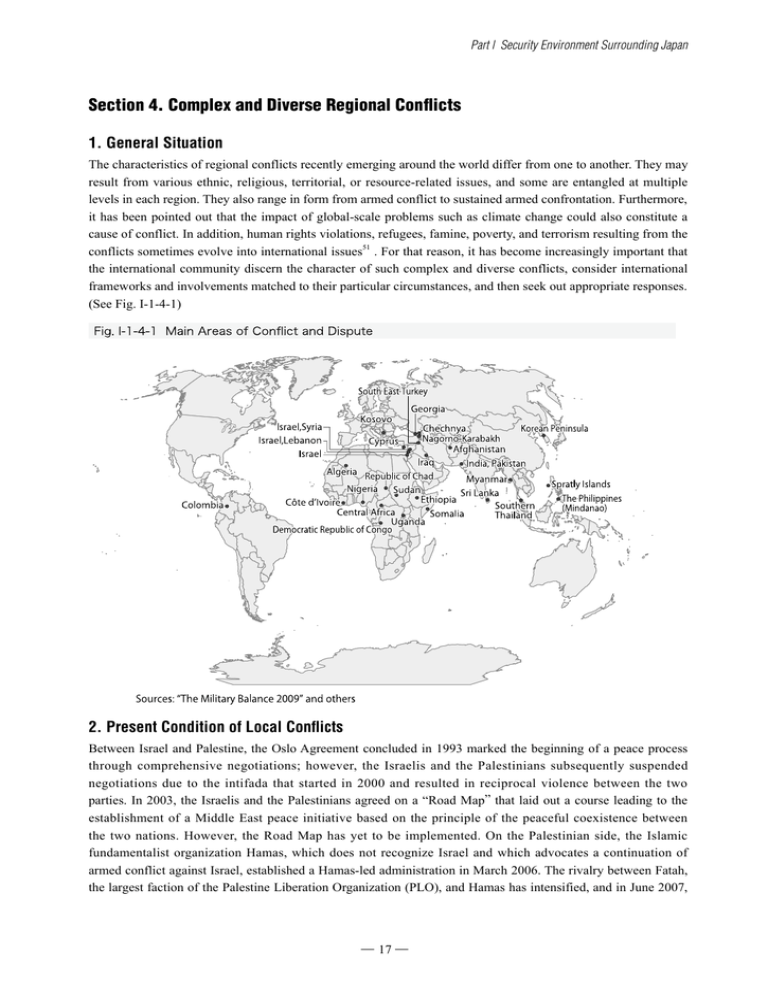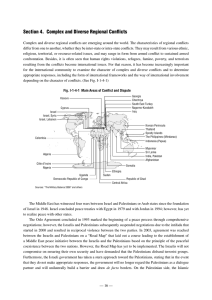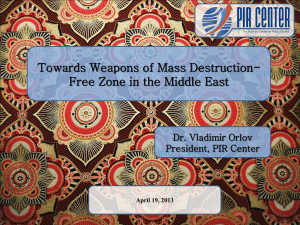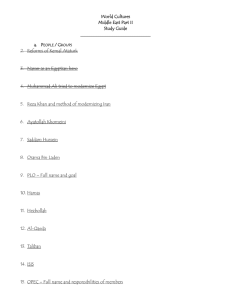Section 4. Complex and Diverse Regional Conflicts 1. General Situation
advertisement

Part l Security Environment Surrounding Japan Section 4. Complex and Diverse Regional Conflicts 1. General Situation The characteristics of regional conflicts recently emerging around the world differ from one to another. They may result from various ethnic, religious, territorial, or resource-related issues, and some are entangled at multiple levels in each region. They also range in form from armed conflict to sustained armed confrontation. Furthermore, it has been pointed out that the impact of global-scale problems such as climate change could also constitute a cause of conflict. In addition, human rights violations, refugees, famine, poverty, and terrorism resulting from the conflicts sometimes evolve into international issues51 . For that reason, it has become increasingly important that the international community discern the character of such complex and diverse conflicts, consider international frameworks and involvements matched to their particular circumstances, and then seek out appropriate responses. (See Fig. I-1-4-1) 2. Present Condition of Local Conflicts Between Israel and Palestine, the Oslo Agreement concluded in 1993 marked the beginning of a peace process through comprehensive negotiations; however, the Israelis and the Palestinians subsequently suspended negotiations due to the intifada that started in 2000 and resulted in reciprocal violence between the two parties. In 2003, the Israelis and the Palestinians agreed on a “Road Map” that laid out a course leading to the establishment of a Middle East peace initiative based on the principle of the peaceful coexistence between the two nations. However, the Road Map has yet to be implemented. On the Palestinian side, the Islamic fundamentalist organization Hamas, which does not recognize Israel and which advocates a continuation of armed conflict against Israel, established a Hamas-led administration in March 2006. The rivalry between Fatah, the largest faction of the Palestine Liberation Organization (PLO), and Hamas has intensified, and in June 2007, ― 17 ― Hamas seized the Gaza Strip. In response to this, President Mahmoud Abbas declared a state of emergency for the entire autonomous region and established an emergency cabinet comprising non-Hamas ministers. Nevertheless, Hamas’ de facto control over Gaza continues, and political turmoil carries on. The United States hosted the Annapolis Conference in November 2007, where agreement was reached between Israel and Palestine to endeavor to conclude a peace treaty by the end of 2008. However, a peace treaty has yet to be concluded. Between December 2008 and January 2009, Israel carried out military air raids and ground assaults on Gaza, in response to the rockets fired at Israel from Gaza. Israel has yet to sign peace treaties with Syria and Lebanon52. Israel and Syria disagree on the return of the Golan Heights which Israel has occupied since the 1967 Arab-Israel War. The United Nations Disengagement Observer Force (UNDOF) is deployed in the Golan Heights region to observe the implementation of ceasefire and military disengagement between the two parties. Concerning Israel and Lebanon, the United Nations Interim Force in Lebanon (UNIFIL) increased its presence following the 2006 clash between Israel and Hezbollah, a Shiite Muslim organization. Although there have not been any prominent conflicts since, political instability has continued in Lebanon, as was shown by their inability to elect a president between November 2007 and May 2008. Furthermore, it has been said that Hezbollah is enhancing its military strength again. In Nepal, armed conflict with the Maoist faction of the Nepal Communist Party has resulted in a significant number of casualties since 1996. As a result of the pro-democracy movement, a new government was formed in April 2006, and a Comprehensive Peace Agreement was signed in November between the Nepalese Government and the Maoists. In response to this agreement, the United Nations Political Mission in Nepal (UNMIN) has been deployed in accordance with Security Council Resolution 1740, and among its duties are to monitor the status of weapons and soldiers. In April 2008, an election for the Nepalese Constituent Assembly was held. In August, the Maoists won the majority of seats and launched a coalition government led by the Maoist faction; however, the confrontation between the political parties continued over the peace making process. In May 2009, the Maoists become the opposition and the coalition government led by UML (Unified Marxist-Leninist) was launched but there are still many issues to resolve in the peacemaking process. In Sudan, a 20-year north-south civil war broke out in 1983 between the Sudanese Government, which is predominantly composed of Muslim Arabs from northern Sudan, and anti-government forces comprising African Christians from southern Sudan. In response to the Comprehensive Peace Agreement (CPA) that was concluded between the north and the south in 2005, the United Nations Mission in Sudan (UNMIS), established by Resolution 1590 of the Security Council, has been deployed and is conducting truce monitoring activities to assist the implementation of the CPA. However, issues still remain, such as preparations for a referendum on the independence of the south scheduled for 2011, the disarmament, demobilization and reintegration of soldiers, and border demarcation between the north and the south. In the Darfur region of western Sudan, conflict intensified between the Arab government and the African anti-government forces in 2003. The conflict in Darfur has produced a large number of internally displaced persons, which the international community, including the United Nations, regards as a serious humanitarian crisis. Following the ceasefire agreement in 2004, the African Union (AU) dispatched the African Anti-government Islamist militants Hizb al-Islamiya in position at the Union Mission in Sudan (AMIS); however, their efforts police station in the Somali capital of Mogadishu [AFP/JIJI] ― 18 ― Part l Security Environment Surrounding Japan to halt the conflict were unsuccessful. After the government and a fraction of the major anti-government forces concluded Darfur Peace Agreement (DPA) in May 2006, the U.N. Security Council adopted Resolution 1769 in July 2007, which stipulated the creation of the AU/UN Hybrid Operation in Darfur (UNAMID). However, instability in the Darfur region continues as some of the anti-government forces refuse to sign the DPA and the deployment of UNAMID units is insufficient to enable them to prevent attacks on UNAMID personnel. Furthermore, the International Criminal Court (ICC) issued an arrest warrant for Sudan,s President Omar Hassan al-Bashir on the charges of the crimes against humanity and war crimes committed in Darfur. Attention has been drawn to aspects such as the response of the government of Sudan, peace process and impact on peace keeping forces. Somalia had been in a state of anarchy since 1991, but in 2005, the Transitional Federal Government (TFG) was inaugurated. However, battle raged between the TFG and the Union of Islamic Courts (UIC), an Islamic fundamentalist organization opposed to TFG. The Ethiopian forces intervened to support the TFG and eliminated the UIC in December 2006. In January 2007, the African Union Mission in Somalia (AMISOM) was established, and in August 2008 in Djibouti, the peace agreement was concluded between the TFG and Alliance for the Reliberation of Somalia (ARS) which was formed by UIC and other groups. In January 2009, the ARS leader Sheikh Sharif was elected as President of the TFG and the withdrawal of the Ethiopian troops from Somalia was completed, which was the condition for the peace agreement. However, since the ruling power of the TFG is weak and the TFG does not yet have control of all the country, there is no prospect of restoring order to the country; the situation remains tense, with continued fighting between the TFG and new Islamist militia groups such as Al-Shabab. In the sea areas surrounding Somalia, the number of incidents of piracy and armed robbery increased rapidly in 200853. The Security Council has adopted four resolutions since the summer of 200854, calling on member states to dispatch ships as anti-piracy measures. Against this background, a number of countries have dispatched their ships to the coastal areas surrounding Somalia to undertake anti-piracy missions. 3. Efforts to Stabilize the International Community The end of the Cold War was accompanied by rising expectations for the peacekeeping system by the U.N., which up to that time had not functioned adequately, and as a result, many U.N. Peacekeeping Operations (PKOs) were established. In recent years, efforts through regional frameworks such as the European Union (EU) and the African Union (AU) have been formed as a means of dealing appropriately with conflict. Other efforts include peacekeeping operations and humanitarian and reconstruction assistance by multinational forces mandated by Security Council Resolutions. Efforts aimed not only at peacekeeping but also at conflict prevention and peacebuilding are also increasing55. Traditionally, PKOs have mainly aimed at preventing reoccurrence of conflict by focusing on monitoring of ceasefires and other tasks after a ceasefire agreement has been reached. Since the end of the Cold War, however, the missions now cover a broad range of operations, including civilian activities such as monitoring of disarmament, monitoring of elections and administration, and humanitarian support for return of refugees56. (See Fig. I-1-4-2) However, the environment surrounding PKOs in recent years has grown increasingly harsh. Since Africa is the main deployment area for PKO missions, and their activities are carried out virtually in the absence of any agreements, they face difficult situations from time to time57. Although some of their activities have been vested with strong authority under Article 7 of the Charter of the United Nations58, there remain issues of securing equipment and materials, ensuring the security of personnel and the capability improvement of forces, all of which are essential for the effective performance of operations in areas with poor infrastructure. While countries in the regions where conflicts occur attempt to carry out voluntary peacekeeping activities such as AU, the capability improvement of forces is an important issue. ― 19 ― ― 20 ― Part l Security Environment Surrounding Japan ― 21 ― Notes: 1) The 2008 Annual Threat Assessment compiled by the U.S. Director for National Intelligence (DNI) in February 2009 and the United Kingdom,s Strategy for Countering International Terrorism compiled by the U.K. Government in March 2009 point out that the leaders of Al Qaeda are being harbored in the Federally Administered Tribal Areas (FATA) of the Pakistan border region. 2) Annual Threat Assessment, DNI (February 2009) 3) Annual Threat Assessment, DNI (February 2009) 4) Country Reports on Terrorism 2007, U.S. (April 2008) 5) The United Kingdom,s Strategy for Countering International Terrorism, U.K. (March 2009) 6) The verdict of the first trial against the Madrid train terrorist attack (October 31, 2007) 7) Under U.N. Security Council Resolution 1386 (December 20, 2001), the International Security Assistance Force (ISAF) was established with the principal mission of maintaining security in Kabul and surrounding areas. Based on U.N. Security Council Resolution 1510 (October 13, 2003), the ISAF has gradually expanded the area of deployment since December 2003. Since October 2006 the ISAF has deployed in the entire territory of Afghanistan. As of April 2009, approximately 58,000 troops from 42 countries have been dispatched to the ISAF. 8) Annual Threat Assessment of the Director of the Defense Intelligence Agency (DIA) (March 2009) 9) In the new strategy, the United States announces that it will, for example, (1) call upon Congress to pass a bill that authorizes $1.5 billion in support to Pakistan every year for the next five years, (2) start regular dialogue between the U.S., Afghanistan and Pakistan, (3) deploy approximately 4,000 troops to train Afghan security forces in addition to the deployment of 17,000 troops that had already been decided in February 2009 and (4) increase civilian personnel on the ground. 10) An Islamic extremist organization established in Algeria in 1998 as the Salafist Group for Preaching and Combat (GSPC). It then changed the name to the current one when it officially joined Al Qaeda in September 2006. 11) The security situation in Algeria has improved although in the 1990s it suffered from frequent terrorist activities by anti-government Islamic Extremists. 12) 2008 Annual Threat Assessment of the DNI (February 2009). 13) Testimony to the House Committee on Foreign Affairs on June 6, 2007, by then Assistant Secretary of State Welch. 14) It has been pointed out that Al-Qaeda in Yemen has grown since its formation in 2006. (The United Kingdom,s Strategy for Countering International Terrorism, U.K. (March 2009)) 15) In 2008, successive bomb attacks took place in Jaipur (North) in May, in Bangalore and Ahmadabad in July, in New Delhi in September, Assam in October and in Mumbai in November. 16) For instance, in October 2002, terrorist bomb attacks in two clubs on the island of Bali killed 202 people. In October 2005, terrorist bomb attacks against restaurants and other places on the island of Bali killed 23 people. 17) 2008 Annual Threat Assessment of the DNI (February 2009). 18) An agreement over ancestral domain between the Philippine government and the MIFL, which is the major controversial issue in the peace negotiations, was declared unconstitutional by the Supreme Court. Immediately after the court decision, some commanders of the MILF, dissatisfied with the ruling, carried out an attack on civilians. This triggered acts of combat between the army and the MILF, which are still going on today. 19) The United States, the former Soviet Union, the United Kingdom, France and China. France and China signed the NPT in 1992. ― 22 ― Part l Security Environment Surrounding Japan 20) Article 6 of the NPT sets out the obligation of signatory countries to negotiate nuclear disarmament in good faith. 21) As of May 2009. 22) South Africa, Ukraine, Kazakhstan and Belarus. 23) Israel, India and Pakistan are major non-member states. 24) A means of attacking the counterpart,s most vulnerable points other than by conventional weapons of war. (e.g. weapons of mass destruction, ballistic missiles, terrorist attacks, cyber attacks) 25) Former Defense Agency, “Basic Concept for Dealing with Biological Weapons” (January 2002). 26) Mustard gas is a slow-acting erosion agent. Tabun and sarin are fast-acting nerve agents. 27) It was reported that a Kurdish village was attacked with chemical weapons in 1988, killing several thousand people. 28) Iraq joined the Chemical Weapons Convention (CWC) in February 2009. 29) A weapon that generates a lethal chemical agent by mixing two kinds of chemical agents through discharge or explosion. The handling and storage of this weapon is easy because of its low lethality before use. 30) In the July 2006 conflict between Israel and Lebanon, it is believed that Hezbollah used a cruise missile to attack an Israeli naval vessel. 31) U.S. Department of Defense “Proliferation: Threat and Response” (January 2001). 32) Dirty bombs are intended to cause radioactive contamination by spreading radioactive substances. 33) Based on these concerns, the United Nations Security Council adopted Resolution 1540 in April 2004, declaring that all states should refrain from providing any form of support to non-state actors that attempt to develop, acquire, manufacture, possess, transport, transfer or use weapons of mass destruction and their means of delivery and adopt and enforce appropriate and effective laws to prohibit these acts. The International Convention for the Suppression of Acts of Nuclear Terrorism also entered into force in July 2007. 34) U.S. President Bush said in a speech in February 2004: “Khan and his associates provided Iran and Libya and North Korea with designs for Pakistan's older centrifuges, as well as designs for more advanced and efficient models. The network also provided these countries with components of centrifuges and, in some cases, with complete centrifuges.” 35) Statement at a press conference with Japanese reporters (September 29, 2004). 36) Dennis C. Blair, DNI of the U.S., stated at the Senate Armed Services Committee in March 2009 that, “The IC continues to assess North Korea has pursued a uranium enrichment capability in the past. Some in the Intelligence Community have increasing concerns that North Korea has an ongoing covert uranium enrichment program.” 37) Then U.S. White House Press Secretary Dana Perino made an announcement that the facility located in eastern Syria bombed and destroyed by Israel in September 2007 was a nuclear reactor that was being secretly constructed for the purpose of producing weapons-grade plutonium with the support of North Korea (April 24, 2008). 38) Extensive behind-the-scenes negotiations began in March 2003 between Libya and the U.S. and U.K., and in December 2003, Libya agreed to dismantle all of its weapons of mass destruction and to allow international organization to carry out inspections. Later, in August 2006, Libya ratified the IAEA Additional Protocol. 39) Testimony of then Director of the U.S. Central Intelligence Agency George J. Tenet before the Senate Select Committee on Intelligence (February 24, 2004). 40) Accusation made by the Deputy Chairman of Ukraine,s Parliamentary Committee on Combating Organized Crime and Corruption (February 2, 2005). 41) This urged Iran to abandon its enrichment-related and reprocessing activities in exchange for assistance in a ― 23 ― 42) 43) 44) 45) 46) 47) 48) 49) 50) 51) 52) 53) 54) 55) civilian-use nuclear power program that would guarantee a fuel supply for a light-water reactor, assistance in the export of civilian aircraft to Iran, and support for Iran,s accession to the World Trade Organization (WTO), etc. U.N. Security Council Resolution 1737 adopted in December 2006 (obliging prevention of the supply, sale or transfer to Iran of materials and technology that could contribute to Iran,s enrichment, reprocessing, or heavy water-related activities or to the development of nuclear weapon delivery systems, and obliging freezes of the financial assets of persons or entities supporting Iran,s proliferation-sensitive nuclear activities or the development of nuclear-weapons delivery systems), U.N. Security Council Resolution 1747 adopted in March 2007 (in addition to the above measures obliging a freezes of the financial assets of additional persons or entities, obliging a bans on the procurement of weapons and related items from Iran, and requesting monitoring and restricting the supply, sale or transfer of tanks, fighter aircrafts, missiles and other such armaments to Iran.), and U.N. Security Council Resolution 1803 adopted in March 2008 (in addition to the above measures, obliging a freezes of assets of additional persons or entities and obliging a bans on the entry of designated individuals into U.N. member states, for their involvement in Iran,s proliferation-sensitive nuclear activities.). Furthermore, U.N. Security Council Resolution 1835, calling for compliance with aforementioned Resolutions, was adopted in September 2008 The U.S. published its assessment as follows: “Iranian military entities were working under government direction to develop nuclear weapons. In fall 2003, Tehran halted its nuclear weapons program. Tehran at a minimum is keeping open the option to develop nuclear weapons.” (National Intelligence Estimate, National Intelligence Council, December 2007; Annual Threat Assessment, DNI, February 2009) In February 2009, Iran started the trial operation of a light-water reactor that was being constructed with the cooperation of Russia, under the framework hat Russia supplies nuclear fuel and collecting spent nuclear fuel. U.S. Department of State Spokesman Robert Wood stated at a press conference that the Iranian lightwater reactor demonstrates that it does not need to develop an indigenous uranium enrichment capacity. DoD Report to Congress, “Measuring Security and Stability in Iraq” (March 2009). Ibid., Annual Threat Assessment of the DNI (February 2009). Annual Threat Assessment of the DNI (February 2009). In a document communicated to the Security Council in December 2007, which requested the extension of the deployment of multinational forces, Iraqi Prime Minister al-Maliki announced that the Government of Iraq considers this to be its final request for the extension of the mandate of multinational forces. This agreement stipulates the withdrawal of U.S. combat forces from Iraqi cities, villages, and localities no later than June 30, 2009 and withdrawal of all the United States Forces from all Iraqi territory no later than December 31, 2011. In March 2009, the U.S. forces announced further reduction of two army brigades in the next 6 months. In April 2007, a panel discussion on the impact of climate change on security was held at the Security Council, in which 55 member and non-member States participated. This shows that the awareness that climate change may have an impact on the security environment is becoming increasingly pervasive. Israel concluded peace treaties with Egypt in 1979 and with Jordan in 1994. According to the International Maritime Bureau, 92 incidents occurred in the Gulf of Aden and 19 off the coast of Somalia in the Indian Ocean. Resolution 1816 (adopted in June 2008), 1838 (adopted in October 2008), 1846 and 1851 (both adopted in December 2008). This includes a proposal submitted in October 2007 calling for the enhancement of the U.N. Department of Political Affairs, which is in charge of conflict prevention and such. In addition, the Peacebuilding Commission, which gives advices on consolidation strategies for post-conflict peacebuilding, began fullscale operations in 2006, and Burundi, Sierra Leone, Guinea-Bissau and Central African Republic are ― 24 ― Part l Security Environment Surrounding Japan currently on the agenda. 56) The scale of participants in these operations has also seen a remarkable increase. The number of personnel dispatched was temporarily reduced to 12,000 after 1993, while large-scale PKO missions were sent to the Balkan Peninsula and Somalia. However, from around 2000, the number of personnel began to rise again following an increase in large-scale missions mainly in Africa and the Middle East. As of the end of February 2009, 16 PKO missions were being conducted in 120 countries, with about 90,000 participants from around the world. 57) In the conflict between Ethiopia and Eritrea, a truce agreement was reached in 2000. In response, the United Nations Security Council set up and operated the United Nations Missions in Ethiopia and Eritrea (UNMEE). However, the mission was wrought with difficulties because of persistent sabotage by Eritrea. The U.N. Security Council finally decided to terminate the mandate of UNMEE in July 2008. 58) For example, some PKOs established in recent years are authorized to take all necessary measures to protect civilians, to guard U.N. facilities, and to maintain security. ― 25 ―








